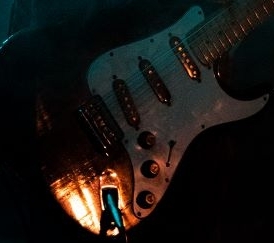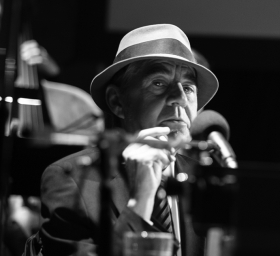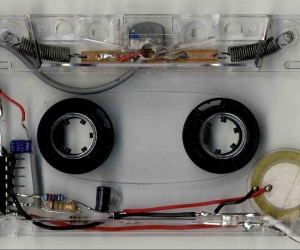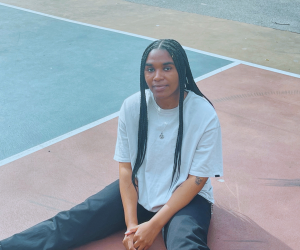
This issue of Musicworks comes preloaded with guitars. Hollow, heavy, bowed, cracked, pedalled, flung. Trusty companions. Feedback demons. Easy to pick up, hard to put down.
While I do not declare this as The Guitar Issue, I do aver that the guitar informed my aleatoric curatorial process for Musicworks 137.
Last year Nova Scotia guitarist and composer Amy Brandon served on the jury of our 2018 Electronic Music Composition Contest, and an article about her was published in Musicworks 134. We met one snowy afternoon in January 2020 in Halifax, where I was attending Upstream Music’s Open Waters festival. She proposed an article about early Canadian guitar-and-electroacoustic works and how “the crazy Toronto guitar scene” in the 1970s helped foster this particular substyle. How could I say no?
Like Musicworks’ very own Marty McFly, Amy goes “back to the future” to discover what Canadian composer and broadcaster Norma Beecroft described back then as “an inexhaustible source of wild music.” That fabulous phrase is also the title of Amy’s sparkling survey article, her debut as a Musicworks contributor.

I came across Casey Koyczan’s inspiring work four years ago when I was researching artists working in the Northern regions of Canada. Casey’s guitar-based music and his futuristic sound art have an industrious, forward momentum that is driven by powerful ideas, visual energy, and personal commitment. When I contacted him this past spring, COVID-19 lockdowns were still holding, and he was woodshedding in his home studio in Winnipeg, where he moved to last fall.
We continued to communicate regularly, and the production of the article became a collaborative effort that was especially meaningful to me during these times of social distancing. (Like many large and small media organizations in Canada, Musicworks staff members have been working from home and will likely continue to do so for the rest of this year.)
Casey was interviewed by Calgary-based writer Mercedes Webb, first-place winner of the 2019 Canadian Art Writing Prize. She and I had two enjoyable “getting to know you” working sessions that reminded me of my early days as an arts writer, when (ahem) nobody had email and I was on the phone pretty much all the time. Via email, I introduced Casey to photographer Robert Szkolnicki, a documentarian of Winnipeg’s experimental-music scenes; they met, in person, at a local park, the location of the portrait on the cover. Casey also contributed photos and the accompanying text for the “tour” of his home studio, which you can visit in the centrespread. What a team!
This is the first issue fully produced and published during COVID-19 times. Longtime readers will notice that there are no 3000-word articles in this issue (there are usually at least three). Our intention is to distribute the magazine’s modest editorial budget more evenly. One editorial goal we are working towards is to achieve gender parity in the overall artist-contributor mix of each issue; scan the table of contents of this issue to see if we’re there yet. Our Board of Directors has also been looking inward and outward to redefine its role in supporting Musicworks and ensuring its mandate is meaningful and inclusive; if you haven’t already, please read their recent statement.
Many of the artists profiled in this issue were asked if or how COVID-19 restrictions have affected their careers or creative space. Their responses are honest and varied. This issue will, I suppose, stand as a kind of time capsule of a moment in modern music: when live became livestreamed, ensembles assembled on Zoom, and audiences applauded with emojis.

As a last-minute note, I would like to honour the vibrant spirit of avant-jazz impresario Ron Gaskin, the gentle man-of-the-music-world in the photo on this page. Ron is well known to many readers and followers of Musicworks, not just in his Toronto stomping ground but across Turtle Island and the wide world of improvised and jazz-leaning music and words. During Ron’s final days, many musicians and music fans shared photos and memories. If you don’t know Ron, I hope you’ve known someone like him. If you’re starting out in music or writing, I hope you will encounter someone like him. Here’s something I wrote the night he passed away (although I did not know it at the time): When I was writing about music for the Toronto Star in the 1990s, Ron Gaskin was putting on the next wave (alternative) jazz festival that happened at the same time as the big jazz festival. He would make cassettes of cool musicians who were booked and bring them to my house. He wouldn't just leave them in the mailbox, he would ring the doorbell and then we would have a conversation on the porch and then I would get the cassettes and info from him. And then usually we'd have a pretty long conversation on the phone about artists he had booked. My kind of music person.
Top photo of Aidan Baker's guitar by Gloria Marchini; middle photo of Casey Koyczan by Devon Lindsay; bottom photo of ron Gaskin by Claire Harvie.


